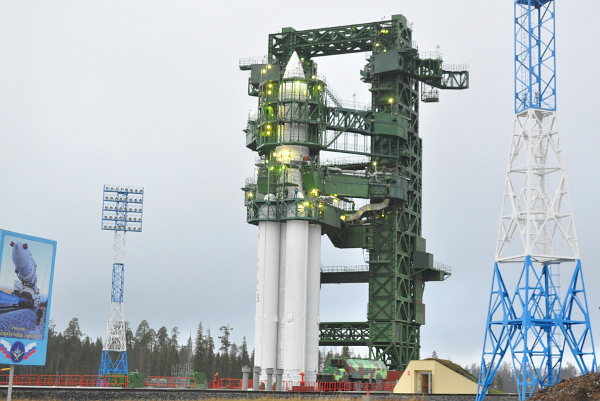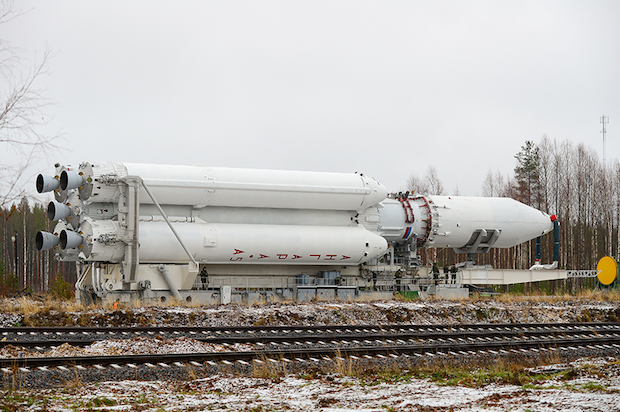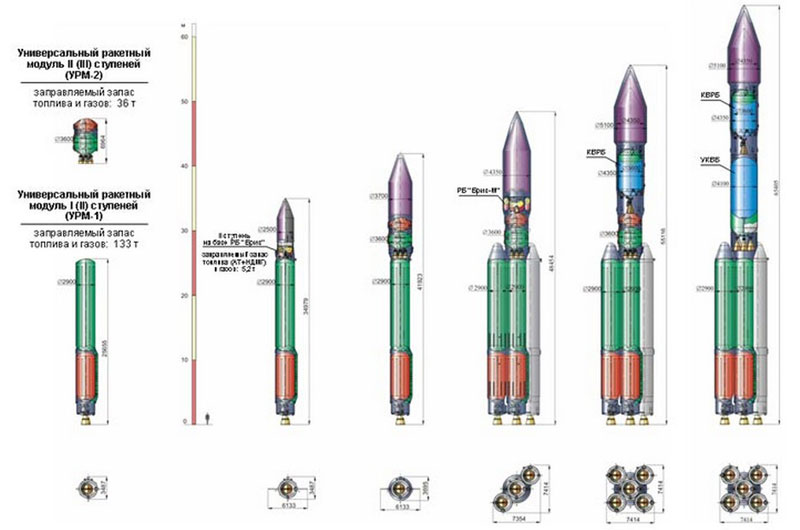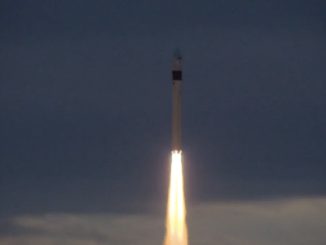
Russia’s powerful new Angara 5 rocket — made of a cluster of five kerosene-fueled main engines — is being prepared for a maiden test flight as soon as Tuesday that could usher in a new era in the Russian space program, according to Russian news reports.
The rocket is being readied for liftoff from the Site 35 launch pad at the Plesetsk Cosmodrome, a military-run space center about 500 miles north of Moscow.
The launch could occur as soon as Tuesday at 0557 GMT (12:57 a.m. EST), according a report by Russia’s Itar-Tass news agency.
Itar-Tass said Sunday the rocket was installed on its launch pad and undergoing preparations for liftoff.
Other Russian news reports have set the Angara 5 launch date for Dec. 25.
The 180-foot-tall Angara 5 rocket is Russia’s most capable new launch vehicle in a generation, and its first test flight is the culmination of a 22-year development effort that cost approximately $2.9 billion, Itar-Tass reported.
Officials say the Angara rocket program — which includes several rocket models to lift light, medium-class and heavy satellites into space — will allow the Russian government to retire the Proton and Rockot boosters and transfer launches from the Baikonur Cosmodrome in Kazakhstan to space centers on Russian territory.

The demonstration launch will not carry an operational satellite. The rocket mission will put a simulated spacecraft packaged inside the rocket’s five-meter (16-foot) diameter payload shroud into orbit thousands of miles above Earth.
Russia has not disclosed the target orbit for the Angara 5’s test launch, but observers suspect the mission will aim for geostationary transfer orbit — an egg-shaped orbit with a high point at geostationary altitude near 22,000 miles in altitude — or geostationary orbit itself.
Weighing 773 metric tons (852 tons) when filled with kerosene, liquid oxygen and hypergolic propellants, the Angara 5 is the biggest Russian launcher to debut since the Energia rocket for the Soviet Union’s Buran space shuttle flew in the late 1980s.
Five RD-191 rocket engines will fire to push the Angara 5 launcher into the sky. The kerosene-fueled engines, made by NPO Energomash of Khimki, Russia, will generate 2.2 million pounds of thrust at maximum throttle.
Engineers derived the single-chamber RD-191 engine from the four-nozzle RD-171 and dual-chamber RD-180 engines flying on the Zenit and Atlas 5 launchers.
Russia tested a smaller version of the Angara rocket in July on a suborbital flight powered by a single RD-191 engine. Engineers designed the Angara 5 booster to use five RD-191 engine cores bolted together to put Russia’s heaviest satellites into orbit.
The five engines will fire in unison for more than three minutes, when four of the outboard boosters will shut down and fall away from the launcher. The core RD-191 engine — operated at a partial thrust throttle setting in the first phase of the flight — will ramp up to full power and continue burning until it consumes all of its kerosene and liquid oxygen propellant supply.
A second stage RD-0124A engine and a Breeze M upper stage — borrowed from Russia’s Soyuz 2-1b and Proton rockets — will finish the job. The flight’s target orbit, likely geostationary orbit or geostationary transfer orbit, will require a series of burns by the Breeze M’s main engine over several hours.

The Angara 5 can place up to 24.5 metric tons — about 54,000 pounds — into a 120-mile-high orbit. On missions with communications satellites heading for geostationary transfer orbit, an Angara 5 rocket can lift up to 5.4 metric tons, or about 11,900 pounds, according to the Khrunichev State Research and Production Space Center, the Angara program’s prime contractor.
Khrunichev and its U.S.-based subsidiary International Launch Services plan to use the Angara 5 rocket to launch commercial communications satellites, eventually replacing the Proton rocket on the global market.
The lightweight single-core Angara 1 launcher is tailored for missions to orbits a few hundred miles above Earth. Engineers could add or remove more Angara rocket cores to send up lighter or heavier satellites, depending on the specifics of each mission.
The modular approach makes for a more flexible rocket, according to Khrunichev. Officials say all of the Angara variants can fly from the same launch pad.
Khrunichev also touts the Angara rocket as an environmentally safe alternative to the Proton rocket, which burns hundreds of tons of toxic hydrazine and nitrogen tetroxide propellants on each launch.
“The commissioning of the Angara system will provide to Russia the capability to launch any type of spacecraft from its own territory, and will secure for our country an independent access to outer space,” Khrunichev said in a statement on its website.
Follow Stephen Clark on Twitter: @StephenClark1.



